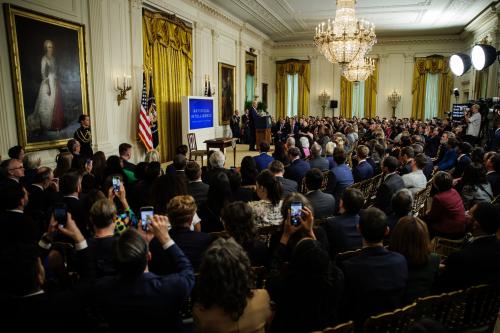In our prior series of papers for Brookings, we explored the rise of national artificial intelligence (AI) strategy documents and sought to make sense of what each country was trying to do and how effectively they were doing it. In our concluding paper, we focused on where the U.S. was lagging behind and proposed options to remedy the lagging. In particular, we recommended three options: 1) apply lessons from the U.S. space race to invigorate talent development, (2) adopt a multi-national consortium approach (similar to NATO) and (3) create a robust partnership with one other country.
Following the guidance of “Deep Throat” of Watergate fame, in this new series of articles, we follow the federal trail of money to understand the federal market for AI work, the hardware, software, and services being purchased. We also track the key players who allocate the money (legislators), spend the money (program managers), and receive the money (vendors). Taken together, this series provides a comprehensive look at federal IT spending, its direction, and its key players.
Data and Methodology
All of the data for this series has been taken directly from federal contracts and was consolidated and provided to us by Leadership Connect. Leadership Connect has an extensive repository of federal contracts and their data forms the basis for this series of papers.
In this initial paper, we analyzed all federal contracts over the last five years that had the term “artificial intelligence” (or “AI”) in the contract description. As such, our dataset included 663 contracts of which 652 identified a funding agency, 556 identified a NAICS code and 504 identified a dollar value, with contract values ranging up to $192 million.
Findings
Out of the 15 NAICS code categories identified in contracts, the data show that over 95% of the AI-labeled expenditures are in NAICS 54, which is for professional, scientific, and technical services. This category had over $1 billion in expenditures with a total of 474 unique award pairs (agency-vendor) over the last five years. This is not surprising, as typically the federal government is one of the largest sources of external funding for research and development, which is the core service of NAICS 54. The second most frequently used code was NAICS 33 (manufacturing), with only 16 unique awards valued under $7 million (0.5% of the total expenditures), so it is clear that NAICS 54 dominates. Overall spending for research and development (of which NAICS 54 is part of) has grown at a double digit rate for several years. This finding suggests an immature market which is focused on the development of research rather than a more mature market which would be focused more on hardware and software devices.
While there are 15 different funding agencies within NAICS 54, 53% of the contracts and 87% of contract value sit within the Department of Defense (DoD). Health and Human Services (HHS) and NASA are distant second to the DoD in terms of number of contracts (with 17% each). Taken together, these contracts only represent 1.5% of total contract spend for this code. Commerce and the Veterans Administration are the next largest by contract spend at approximately 4% each.
There are a total of 307 different vendors with 474 contracts. No vendor deals with more than three funding agencies, which reflects a very niche approach for the vendor community. Three vendors (AI Solutions, AI Signal Research and United Solutions) deal with three agencies while fourteen different vendors deal with two agencies and the remaining 290 vendors deal with a single funding agency. Additionally, there are only 62 companies with more than one contract but there are 245 with just one. There is only one vendor with more than 10 contracts (AI Solutions) and only two others with more than five (AI Signal Research and AI Biosciences).
While there are 15 different funding agencies within NAICS 54, 53% of the contracts and 87% of contract value sit within the Department of Defense (DoD).
There are 327 funding agency-vendor dyads. Of all the dyads, AI Solutions is the only vendor with more than five contracts with a single funding agency – 56 with NASA and 10 with DoD. There are 267 unique dyads where only one contract exists. Again, this reflects a very fragmented vendor community that is operating in very narrow niches.
Analysis
Taken together, we see a highly-fragmented market which is dominated by smaller vendors who generally have a single contract for AI-related services. Many of these vendors are small vendors and, for these vendors, the AI-related work represents a substantial percentage of their annual revenue. Interestingly, co-location also features prominently. That is, many of these vendors are located in close proximity to their federal client and we suspect that prior relationships – personal or professional – may exist. We see these relationships as healthy since it reflects an ecosystem of vendors that are growing in response to specific needs.
This does not mean that the larger traditional technology firms such as RAND, Northrop Grumman, Accenture, IBM, Booz Allen Hamilton and Raytheon are absent from these contracts. However, like with their smaller counterparts, these larger firms are still establishing beachheads where AI could possibly fit. If history holds, we would expect these larger firms to relatively quickly explode in their overall contractual presence given their previously existing relationships with federal decision makers and their historic willingness to acquire smaller firms to quickly scale up.
From the client side, the large number of relatively small contracts shows that the federal government is still very much in an experimental phase of purchasing AI and is likely looking for specific use cases where AI is appropriate. This would explain the focus on research-based contracts as opposed to hardware and software-based contracts. From a risk management standpoint, this is a good idea. With a large number of small vendors each having a single contracts, we perceive that the government is adopting a strategy of letting a thousand flowers bloom, with the hope that this will lead to eventually figuring out the best approach to AI.
However, there is also a darker future that could potentially result if this approach is taken. As discussed previously, the U.S. is significantly behind in AI development and, in particular, trails China by a substantial margin. In our analysis of China’s national AI plan, it is clear that the Chinese national government is taking the lead on the development of AI strategies and projects. Meanwhile, other entities, such as the private sector, are very small players in the plan. This means that China can quickly identify the best prospects for AI and direct substantial funding on a few projects which would appear to have the highest degree of success.
By contrast, the U.S. plan is much more of a collaborative approach, with the federal government, private industries and universities all expected to play an active role. While we have little doubt that the U.S. strategy will eventually yield good outcomes, it will likely be a more slowly evolving strategy since preferential treatment is not being given to the most promising ideas. At least at present, the focus appears to be on cultivating a wide variety of projects rather than focusing on a more narrow set.
The one major focus area for the U.S. federal spending on AI is within the DoD. It appears that the DoD is being used as an incubator of sorts for AI projects, despite being only one of many agencies envisioned to do so in the U.S. national plan. But, given the DoD’s willingness to spend on new technologies, it is not surprising that this is the major focus area. We would expect that, over time, other federal agencies would be much more willing to invest in AI.
While the U.S.’s broad approach to AI will likely yield benefits in the future, it is likely to be a much more slowly evolving strategy than the one embraced by China. Further, the more diversified U.S. strategy makes it challenging for federal project/program managers to share insights developed from the individual projects. This means that the federal government is largely relearning the same lessons from multiple projects, which is not a time-efficient strategy.
The current framework for solving this coordination issue is the National Artificial Intelligence Initiative Office (NAIIO), which was established by the National Artificial Intelligence Initiative Act of 2020. Under the Act, the NAIIO is directed to:
…sustain consistent support for AI R&D, support AI education…support interdisciplinary AI research…plan and coordinate Federal interagency AI activities…and support opportunities for international cooperation with strategic AI…for trustworthy AI systems.
While the intent of this Act and its formal structure are admirable, the current federal spending does not seem to reflect these lofty goals. Rather, we are seeing a federal market that appears to be much more chaotic than desirable, especially given the lead China already has on the U.S. in AI activities.
Summary
The federal market for AI is in its very early stages but already we see how the market is likely going to move in the coming years. While we think that the diversified approach taken by the U.S. is likely to eventually pay off, it is equally likely to cause the U.S. to fall even further behind China over the next several years. Enhancing the power and direction of NAIIO would be an excellent first step to bring structure to this chaotic marketplace.
Building on the findings from this paper, further papers in this series will explore the multi-faceted relationships between federal program managers, AI consulting firms, and elected representatives.








Commentary
Understanding artificial intelligence spending by the U.S. federal government
September 22, 2022